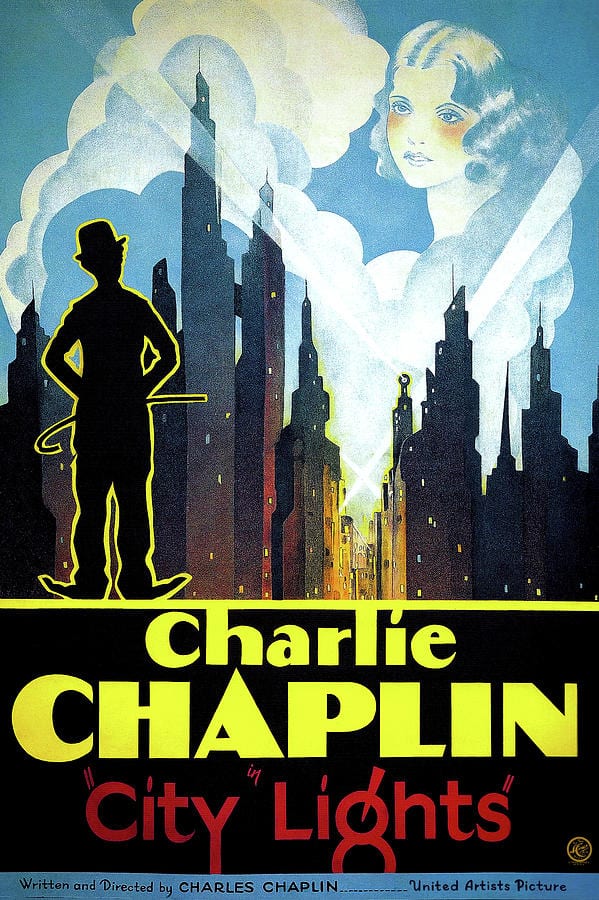City Lights, which celebrates its 90th anniversary this year, is remembered by many as Charlie Chaplin’s most masterful mélange of comedy, romance and social criticism. The film, released at a critical time for both Chaplin and society as a whole, reaffirmed his status as the most famous entertainer on the planet. Though Chaplin stood unrivalled as the king of the emerging mass medium of film, he was also a man torn between the revolutionary expectations of his politics and the romantic expectations of his art form. Throughout his career, Chaplin wrestled with the immediacies of popularity, profit and stardom and a deeper desire for redistributive change—both within and beyond the film industry. His story still resonates, echoing through Martin Scorsese and Marvel, Ari Aster and A24, even Ken Loach and the Tory government.
The man behind the moustache held almost as many identities (and opinions) as his Little Tramp character had theatrical incarnations. He was a global star; a budding revolutionary; a sentimentalist; a political dissident; a comedic everyman. He would eventually be exiled from the same America that had once exhilarated him. Even the Little Tramp’s costume was intended to be a contradiction: “the pants baggy, the coat tight, the hat small and the shoes large”.
Come 1931, the world around him was exacerbating Chaplin’s tension. The economic downturn of the Great Depression had led to an emergence of progressive and radical politics. There was an increased demand, at least among intellectuals, for “socially conscious art”. As the Little Tramp grew into a universal image, defined by his misfortune and hardship, one question remained on the lips of left-wing critics: was he a revolutionary?
Chaplin did not intend for City Lights to be an explicit criticism of the Great Depression, but the film addresses many of the problems of the period. It contrasts the frivolous hedonism of 1920s flapper parties and consumer society, with the meagre sadness of life on the breadline.
The Tramp is the intermediary between two people who are unable to see him for who he really is. He first encounters a poor blind flower girl, who mistakes him for a millionaire, before stumbling across a suicidal millionaire, who only ever recognises him as a friend when he’s blind drunk. The Tramp transfers money from the rich millionaire to the poor flower girl, later discovering news of a medical treatment that can restore sight to the blind. The plot builds towards the lingering, ambiguous ending in which the Tramp is gazed upon by the now-seeing flower girl in one of the most poignant, well-crafted moments in cinematic history.
City Lights both cemented Chaplin’s artistic genius and cut to the core of his dilemma. For supporters of Chaplin’s work, he was a pioneer. He was one of the first in Hollywood to harness the democratising force of film, communicating the working-class struggle. Chaplin had fought hard for his artistic and financial autonomy, helping to establish the independent United Artists in 1919—a remnant of which remains today as United Artists Releasing. His rebellion against the vertical studio model trailblazed a path for other independent studios today, including A24, IFC Films and Annapurna Pictures.
At the same time, the seriousness of Chaplin’s art was questioned as he continued to juggle motivations of politics and profit. Film critic Harry Potamkin accused Chaplin of falling back on the “formula romantic relationship”, abandoning his deeper social critique. Others even argued that Chaplin’s reliance on the clownish Little Tramp character formed a passive and uncritical audience who would rather laugh than strike. This critical conversation still plays out today. The radical distribution process of Ken Loach’s I, Daniel Blake (2016), in which distributors joined with trade unions and media companies to put on hundreds of free screenings, was an attempt to blend activism and cinema—overcoming the problem of the uncritical audience.
The criticism of City Lights seemingly landed with Chaplin. In his autobiography, he mentions being “depressed” by remarks that suggested the film “verged on the sentimental”, remarks to which he “found [himself] agreeing”. Though Chaplin maintained the belief that art should be more than simply an accessory to politics, over time he appeared to accept its role in providing moral and political instruction. He became more outspoken during his world tour in 1931-1932 and in his support for the ‘End Poverty in California’ (EPIC) campaign, and this would be reflected in his next three films: Modern Times, The Great Dictator and Monsieur Verdoux. Though never certified as a communist, Chaplin was brought before the House Committee on Un-American Activities (HUAC) and then later exiled from the United States of America in 1952.
Despite the indications, however, Chaplin never became the benevolent and unselfish messiah many revolutionaries wanted him to be. Screenwriter Budd Schulberg said of Chaplin, “[He] was another of those idealists who talked socialism and practised capitalism.” Towards the end of his life, Chaplin himself had stated, “I went into the business for money, and the art grew out of it.”
This being said, Chaplin expertly addressed eternal themes through timeless humour. His genius was that he desired for his art to hold moral and political weight, without sacrificing its ability to communicate feeling with life-giving intensity. It was a balance that—as history would tell us—he impossibly achieved.
Words by Ben Thomas
This article was published as part of The Indiependent‘s May 2021 magazine edition.
Support The Indiependent
We’re trying to raise £200 a month to help cover our operational costs. This includes our ‘Writer of the Month’ awards, where we recognise the amazing work produced by our contributor team. If you’ve enjoyed reading our site, we’d really appreciate it if you could donate to The Indiependent. Whether you can give £1 or £10, you’d be making a huge difference to our small team.
